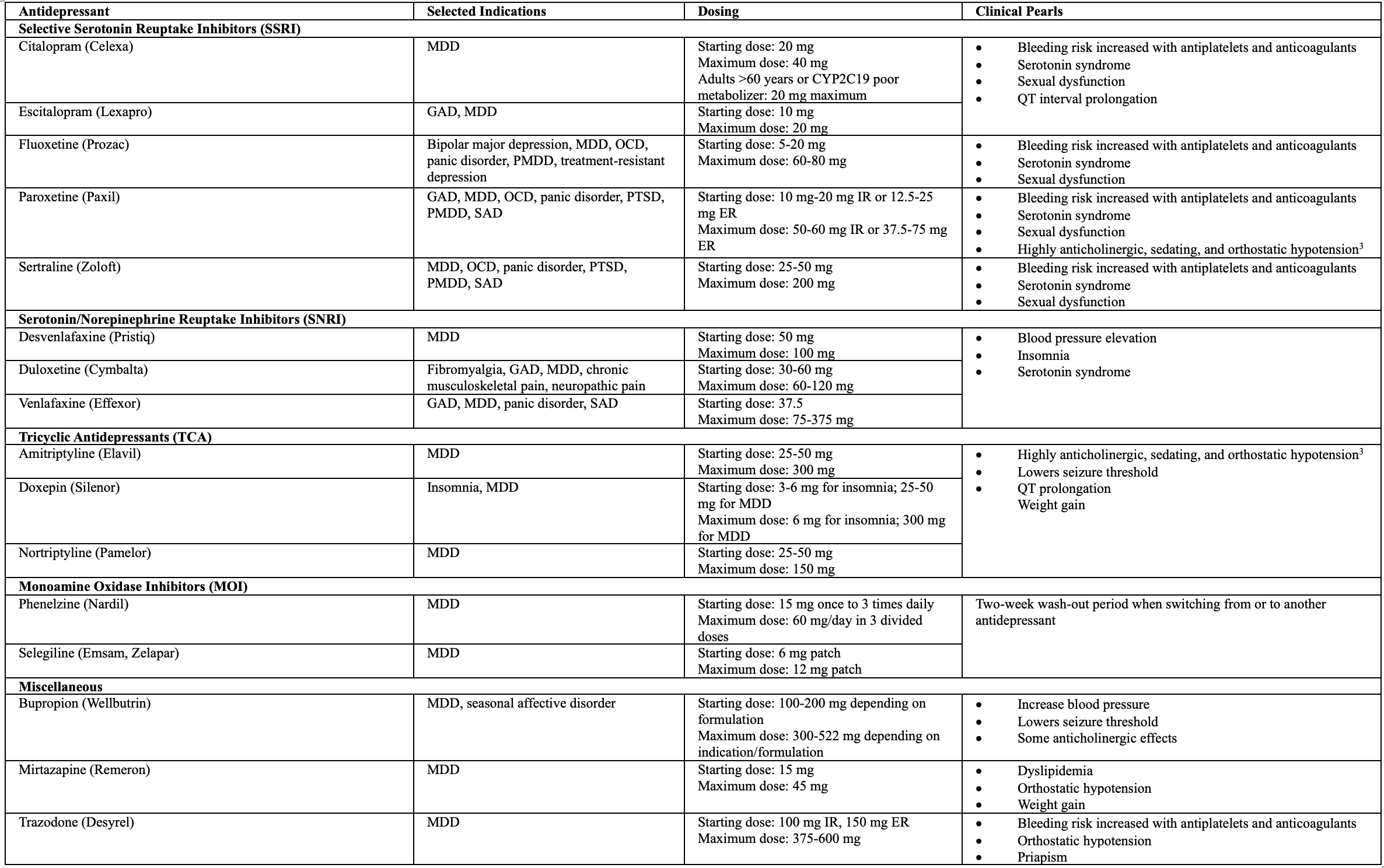News
Article
Beyond Depression: Antidepressants and Their Diverse Indications
An overview of antidepressant medications and their indications to inform health care professionals of their wide use and to better understand which antidepressant to recommend based on patient-specific characteristics.
Antidepressant medications have a wide range of indications, including treatment of depression, anxiety, insomnia, neuropathic pain, and many other chronic medical conditions. Many mental health medications are indicated for multiple disease states, therefore, knowing the common indications for each could have the potential to decrease pill burden for patients by using a single medication to treat multiple conditions.
Image credit: kwanchaift | stock.adobe.com

This article will provide an overview of antidepressant medications and their indications to inform health care professionals of their wide use and to better understand which antidepressant to recommend based on patient-specific characteristics.
Depression
There are a wide range of antidepressants on the market with numerous mechanisms of action. These include selective serotonin reuptake inhibitors (SSRI), serotonin/norepinephrine reuptake inhibitors (SNRI), tricyclic antidepressants (TCA), and monoamine oxidase inhibitors.1
Generally, most patients are started on an SSRI, SNRI, bupropion, or mirtazapine for initial treatment of depression. To determine which antidepressant to choose, it is important to evaluate the patient’s comorbidities and the anticipated adverse effects.
For example, if the patient has a history of seizures, bupropion should be avoided because it is known to lower the seizure threshold.
Anxiety
Approximately 85% of patients diagnosed with depression have a comorbidity of anxiety.2 There are several antidepressants that have a dual indication to treat general anxiety disorder.
SSRI and SNRI are used as first-line agents for depression and anxiety.1 For example, escitalopram and paroxetine, both SSRIs, are FDA-indicated to treat generalized anxiety disorder. Duloxetine and venlafaxine are SNRIs used to treat anxiety.
SSRIs might be preferred over SNRIs if the patient already has a history of hypertension due to norepinephrine elevating blood pressure. In the elderly population, other SSRIs are favored over paroxetine due to its anticholinergic properties and increased risk for orthostatic hypotension.3
Pain
Depression can negatively affect how patients perceive and rate their pain.4 Untreated chronic pain can lead to a negative impact on depressive symptoms for a patient.
To improve therapeutic outcomes, there are several antidepressants that have a dual indication for the treatment of chronic pain. For example, duloxetine, an SNRI, is a treatment option for neuropathic pain and chronic musculoskeletal pain.1,4
TCAs, such as nortriptyline, are also treatment options for neuropathic pain, but should be avoided or used with caution in the elderly population due to anticholinergic properties.3
Insomnia
Approximately 1 out of every 3 adults report at least 1 insomnia symptom, whether that be difficulty initiating sleep or maintaining sleep.5 Patients with insomnia have an increased risk of developing depression or relapsing after depression remission.
Pharmacologic options for the treatment of insomnia that also have indications for treatment of depression are TCAs and mirtazapine.1 According to the American Geriatric Society, tricyclic antidepressants have an increased fall risk in elderly patients due to anticholinergic properties and increased risk for orthostatic hypotension.
Therefore, tricyclic antidepressants should be avoided, if possible, in this population.3 Mirtazapine has a lower fall risk, but can still cause orthostatic hypotension similar to TCAs.
Post-traumatic stress disorder (PTSD) and obsessive-compulsive disorder (OCD) treatment
PTSD and OCD have been linked to depression in patients.6,7 PTSD patients are 3 to 5 times more likely to have depression than those without this disorder.6
Overlap in first-line treatment of OCD and PTSD is similar. For example, first-line treatment for PTSD includes SSRIs or venlafaxine and first-line treatment of OCD includes SSRIs.8,9 Fluoxetine, paroxetine, and sertraline are FDA-indicated for OCD treatment. Paroxetine and sertraline are FDA-indicated for PTSD treatment as well.
Table: Overview of antidepressants and their dosing1,10

Table abbreviations: Extended release (ER), generalized anxiety disorder (GAD), immediate release (IR), major depressive disorder (MDD), obsessive-compulsive disorder (OCD), post-traumatic stress disorder (PTSD), premenstrual dysphoric disorder (PMDD), and social anxiety disorder (SAD).
Conclusion
Many patients with depression may also have other comorbidities, such as GAD, PTSD, or chronic pain. Antidepressant medication indications are vast, which may create opportunities to minimize medication burden by utilizing antidepressants that have dual indications for these comorbidities.
Appropriate antidepressant selection can improve quality of life for a patient, so using careful consideration when choosing the correct medication(s) for a patient is the responsibility of health care providers.
References
- Gelenberg AJ, Freeman MP, Markowitz JC, et al. American Psychiatric Association practice guidelines for the treatment of patients with major depressive disorder. Am J Psychiatry. 2010;167(Suppl 10), 9-118.
- Tiller JW. Depression and anxiety. Med J Aust. 2013;199(S6):S28-S31. doi:10.5694/mja12.10628
- By the 2023 American Geriatrics Society Beers Criteria® Update Expert Panel. American Geriatrics Society 2023 updated AGS Beers Criteria® for potentially inappropriate medication use in older adults. J Am Geriatr Soc. 2023;71(7):2052-2081. doi:10.1111/jgs.18372
- Bonilla-Jaime H, Sánchez-Salcedo JA, Estevez-Cabrera MM, Molina-Jiménez T, Cortes-Altamirano JL, Alfaro-Rodríguez A. Depression and pain: use of antidepressants. Curr Neuropharmacol. 2022;20(2):384-402. doi:10.2174/1570159X19666210609161447
- Morin CM, Jarrin DC. Epidemiology of insomnia: prevalence, course, risk factors, and public health burden. Sleep Med Clin. 2022;17(2):173-191. doi:10.1016/j.jsmc.2022.03.003
- Kessler RC, Sonnega A, Bromet E, Hughes M, Nelson CB. Posttraumatic stress disorder in the National Comorbidity Survey. Arch Gen Psychiatry. 1995;52(12):1048-1060. doi:10.1001/archpsyc.1995.03950240066012
- Goodwin GM. The overlap between anxiety, depression, and obsessive-compulsive disorder. Dialogues Clin Neurosci. 2015;17(3):249-260. doi:10.31887/DCNS.2015.17.3/ggoodwin
- Koran LM, Hanna GL, Hollander E, Nestadt G, Simpson HB; American Psychiatric Association. Practice guideline for the treatment of patients with obsessive-compulsive disorder. Am J Psychiatry. 2007;164(7 Suppl):5-53.
- Bandelow B, Allgulander C, Baldwin DS, et al. World Federation of Societies of Biological Psychiatry (WFSBP) guidelines for treatment of anxiety, obsessive-compulsive and posttraumatic stress disorders - Version 3. Part II: OCD and PTSD. World J Biol Psychiatry. 2023;24(2):118-134. doi:10.1080/15622975.2022.2086296
- In: Lexi-Drugs [database online]. Hudson, Ohio: Wolters Kluwer Health.Updated periodically. Accessed September 15, 2023.
Newsletter
Stay informed on drug updates, treatment guidelines, and pharmacy practice trends—subscribe to Pharmacy Times for weekly clinical insights.






